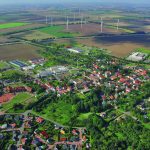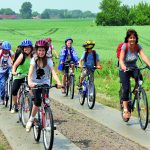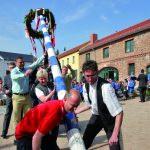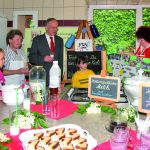Hohe Börde, Saxony-Anhalt, Germany
The municipality Hohe Börde is located in the area around Magdeburg and therefore well developed in regards to traffic and easily accessible. The merger of 14 independent municipalities in 2010 gave birth to Hohe Börde. The “young” municipality with an area of 172 square kilometers and 18,400 inhabitants decided to use all its strength to strike new paths whilst breaking free from the chains of former GDR (German Democratic Republic) structures.
After the fall of the Wall, agricultural cooperatives were privatized and companies with an average size of 100 to 400 hectares were created. Hohe Börde is blessed with fertile soil and a large agricultural potential. The agricultural is highly mechanized and specializes in crop cultivation – mainly grain, potatoes, and sugar beets. The production of biomass for energy generation is limited to five percent due to the high-quality soil. Wind power also plays a major role.
Local supply (other than agriculture), and therefore the regional added value, primarily include businesses and trade along the nearby highway as well as stores within the villages. An interesting product on the estate “Gut Glüesig” which is highly associated with organic farming and direct marketing will also assist with value creation in the future. In addition, the elder-office in a former quarry shed in the village of “Niederdodeleben” functions as documentation- and information center regarding black elder. Numerous specialties are derived and distributed from the appendant elder-garden.
In the village centers efforts are being made to maintain distinctive buildings like the so-called “beet villas” (former farm build-ings) and revitalize vacant properties. Furthermore, churches are oftentimes converted and community centers created as cultural meeting points. This is supposed to preserve the original sense of belonging within the villages of the large municipality of Hohe Börde. On the other hand, in order to strengthen the identity of the new municipality, the citizen association “foundation life within Hohe Börde” was founded.
It is striking that there is a variety of modern social institutions, e. g. a sufficient availability of childcare and public schools, which has enabled the municipality to contain out-migration and keep the number of inhabitants within the villages constant. An interesting pilot project is the estate “Gut Glüesig” which is run by the Caritas: The project integrates people with special needs into the production process of the organic farm. At the same time, “days of encounter” with students from surrounding cities are held in order to raise awareness for agriculture as well as foster the living-together with handicapped people.
A generation-friendly togetherness is the number one priority in the municipality. Furthermore, citizens’ participation, co-determination, and the definition of goals and key areas of action as a group within the individual villages are promoted. Due to the short development as a new municipality, many initiatives are still in the early stages.
With the municipality as the driving force and under the leadership of an engaged mayor, Hohe Börde was able to receive large public funds which were primarily used for restructuring measures during the first developmental phase and are now being used in order to fund several projects. This dynamic approach is future-oriented and exemplary.
Evaluated: 2014




